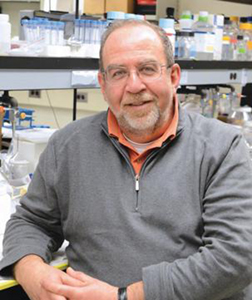Principal Investigator

Harvey Goldberg
BSc McGill, M.Phil London, PhD Alberta
Assistant Director, Schulich Dentistry
Professor, Dentistry Oral Biology
Professor, Biochemistry
hagoldbe@uwo.ca
Schulich School of Medicine & Dentistry,
Western University,
London, ON, Canada N6A 5C1
519.661.2182
Dr. Goldberg discovered his passion for bones and the biomineralization process in the 70s when he decided to do his fourth-year undergraduate project on osteogenesis imperfecta, a brittle bone disease. He hasn’t looked back since. This interest has helped Goldberg publish numerous influential papers and receive significant funding for his research.
A recent accomplishment was a Canadian Institutes of Health Research operating grant in 2013. Valued at $750,000, it is funding a project entitled “Functional Characterization of Bone Sialoprotein”. Although Goldberg is the principal investigator on this project, Schulich Medicine & Dentistry’s Graeme Hunter, PhD, and Frank Beier, PhD, have brought and will continue to bring their expertise to the project as well. “We’re interested in biomineralization - how the process of mineral formation in bones and teeth occur,” Goldberg explained.
Twenty years ago, Goldberg and Hunter published a significant paper in Proceedings of the National Academy of Science that showed bone sialoprotein was able to cause the nucleation, or the initial formation, of hydroxyapatite, the mineral found in bones and teeth. “Throughout the years, we have demonstrated this protein to have multiple functions including the ability to bind collagen and mineral, promote bone cell attachment and differentiation and drive mineral formation,” he added.
A few years ago, Goldberg and his team started working on a transgenic mouse line that was missing bone sialoprotein. In a collaborative study with Dr. Martha Somerman from the National Institutes of Health, they looked at the periodontal tissues and discovered major defects of these tissues including a disorganized and detached periodontal ligament, as well as loss of alveolar bone. It became apparent from the studies that bone sialoprotein was critical for the formation of acellular cementum, a lining of the root of the tooth, which is where the collagen of the periodontal ligament inserts into the tooth. If the acellular cementum is deficient or absent like Goldberg and his team saw in the mice, this would lead to defects similar to that seen in periodontal disease but without the inflammation. If the periodontal ligament does not attach to the tooth, ultimately the teeth become loose and the alveolar bone that surrounds the tooth is lost because of disuse.
Goldberg and his team want to figure out the mechanism to account for bone sialoprotein’s roles in bone and tooth formation. His goal is to understand what it does and how it does it, as this information could be used to develop potential therapeutics for periodontal disease and for promoting bone regeneration and repair. In spite of significant research and recent advances, Goldberg said many procedures performed and materials used in dentistry are not always based on solid scientific evidence. This is why he believes research in the field of dentistry is important. “Basic and applied research in dentistry is critical - we don’t want to see oral health professionals performing procedures with products just because companies tell them it’s the way to do things,” he said. “Evidence-based dentistry should be the rule and not the exception.”
Goldberg enjoys conducting his research, and explained providing an answer or proof that addresses a hypothesis is the rewarding part of his work. “Science is 90 per cent boredom because of the numerous control experiments and repetitions of experiments that are required, but we become truly excited with a result that clearly addresses the scientific question,” he said. “That’s the absolute high.”








